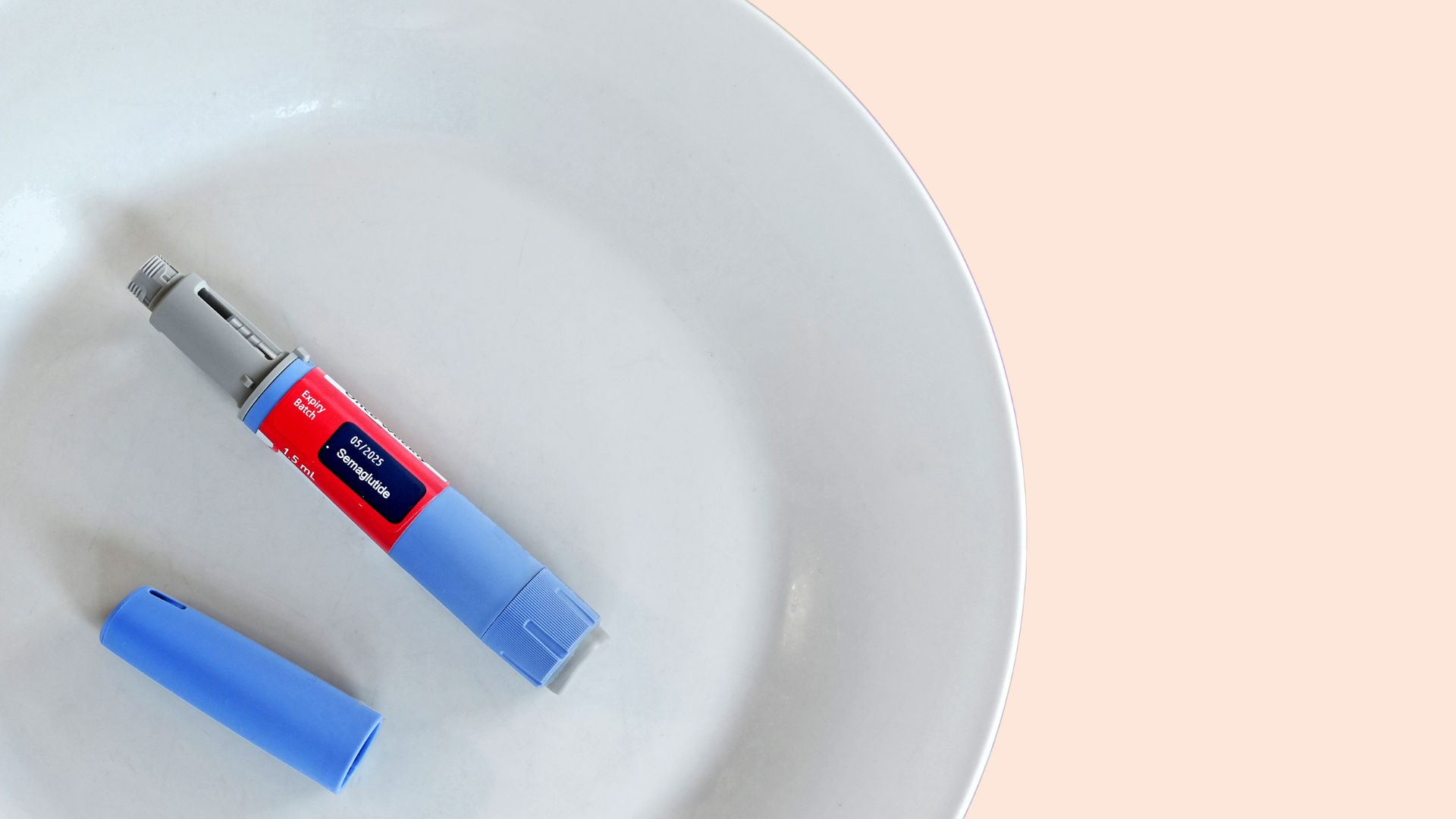What is Ozempic face? Plus, why it really happens and how to fix it
Ozempic face is one of the most famous reported side effects of the injectable. Here, three doctors reveal what you need to know about it


Like all pharmaceuticals, there are side effects to weight loss drugs - and so-called "Ozempic face" is one of the latest to be added to the list. While it's not an official side effect listed by the manufacturer, Novo Nordisk, users have taken to social media platforms to share how they've seen the drug change their faces.
Ozempic is one of two brand names for semaglutide, a glucagon-like peptide-1 receptor agonist - or GLP-1 RA for short. This medication prompts the body to produce more insulin, which reduces blood sugar levels. Approved by the FDA for those with type 2 diabetes, some doctors started prescribing Ozempic off-label for weight loss following a shortage of Wegovy, a fellow medication containing semaglutide at a higher dose, which was specifically approved by the FDA for weight loss.
Following the skyrocketing popularity of the drug, #ozempicface has now hit over 23 million views on TikTok with hundreds of users - either those taking the drug themselves or healthcare professionals - speaking about it. Some are warning other potential users about the side effect, while others have said Ozempic face pales in comparison to the mental and physical benefits they've experienced on the drug. And some say they haven't experienced the side effect at all. Doctors, in turn, have been urging those wanting weight loss injections to seek medical advice and proper prescription to ensure the correct dosage before starting a program.
What's clear is that the attention around Ozempic for weight loss hasn't slowed down, despite the reported side effects - but will Ozempic face change that? Here, woman&home speaks to an aesthetic doctor, a dermatologist, and an aesthetic surgeon about the condition, how to avoid it, and how to fix it if you're currently taking Ozempic or you're just eager to learn more about the drug.
What is Ozempic face?
When people refer to the term "Ozempic face", they are typically talking about the phenomenon of facial weight loss that can occur with the medication, explains Dr Grace Hula, an aesthetic doctor. "Some people who take Ozempic can develop increased wrinkling or hollowing of the face as they lose weight," she explains. "A loss of volume in the face can make facial features appear more pronounced."
The condition was reportedly coined by Dr Jerard Frank, a New York-based dermatologist who noticed patients were experiencing serious fat loss after taking the drug, leading to a more aged appearance, sagging, and an overall gaunt look around their face, according to The New York Times.
"I see it every day in my office," Dr Frank says in the article. "A 50-year-old patient will come in, and suddenly, she's super-skinny and needs filler, which she never needed before. I look at her and say 'How long have you been on Ozempic?' And I'm right 100 percent of the time. It's the drug of choice these days for the 1 percent."
Sign up for the woman&home newsletter
Sign up to our free daily email for the latest royal and entertainment news, interesting opinion, expert advice on styling and beauty trends, and no-nonsense guides to the health and wellness questions you want answered.
Ozempic face is a very natural response to extreme weight loss though, explains Dr Hula, who is also the founder of G&M Healthcare. "The fat that stretches and cushions the skin is no longer in place. There is also a loss of collagen and elastin which reduces the elasticity of the skin."
Drastic weight loss in a short time period can also deplete the skin and body of its essential nutrients, dermatologist Dr Radmila Lukian tells woman&home. "These nutrients are vital for overall skin health and wellbeing. Without them, the skin can suffer from severe laxity, wrinkles, and more."
Ozempic face is also just the name of the particular side-effect given the growing reputation of and intrigue around Ozempic, particularly in recent months. The condition itself has been reported, per the same New York Times article, with other semaglutide and tirzepatide (another anti-diabetic medication) injections, such as Mounjaro.
It's also not just weight loss injectables that cause can the condition since Ozempic face is a side effect of losing weight quickly - rather than the drug itself. "These changes can occur with other rapid weight loss methods too," confirms Dr Hula, including severe calorie restriction.

Ozempic face side effects
Depending on how much weight you lose while taking Ozempic, the effect will be different. But those taking Ozempic may see the following side effects around the facial area, according to Dr Hula and Dr Lukian of the Lucia Clinic:
- Accelerated signs of aging, like an increase in lines and wrinkles
- Loss of fat around the face, which can cause the skin to become loose and start sagging
- A hollowed-looking facial appearance
- Redness, rashes, and itching
According to the FDA prescribing information, other general side effects users may experience with Ozempic include gastrointestinal issues like nausea, vomiting, and diarrhea, along with abdominal pain and constipation. Although rarer, other potential side effects include hypoglycemia (with symptoms like fatigue and dizziness), changes in vision, pancreatitis, and kidney and gallbladder problems.
Whether Ozempic causes hair loss was also a question posed by those on the drug earlier this year, following reports of shedding and "clumps" coming out in the shower. However, the experts revealed this was also down to the rapid weight loss.
What is the best treatment for Ozempic face?
There are several treatment options for Ozempic face, the experts say, including cosmetic, dietary, and lifestyle options:
- Cosmetic treatments: "You can go down the treatment route to help improve the appearance of your face with dermal fillers, micro-needling, lasers, and facials to add back volume," says Dr Lukian. Other injectable treatments and skin boosters, like Profhilo, can also help with this, says plastic surgeon Dr Omar Tillo.
- Collagen treatments: "Some treatments that aim to stimulate the production of collagen [the main structural protein in the body's connective tissues], for example, radiofrequency such as Fotona and Morpheus 8 may help improve the quality of the skin," says Dr Tillo, who is also the senior medical director at CREO Clinic.
- Reduce the dosage: "Reducing the dose of Ozempic to slow down the rapid weight loss and its effect on the facial skin and fat" is one of the best ways to avoid Ozempic face, says Dr Hula.
- Stop taking the drug: While this goes for any weight loss injectable, Dr Hula says that when people stop taking Ozempic, it takes about five weeks to clear from the body. "And by this time, the changes that caused Ozempic face usually start reverting back, reducing the look." If you're looking to change your program at any time, speak to your prescriber or a health practitioner.
How to avoid Ozempic face
Managing the condition and reducing its visibility, provided you are struggling with it, is mostly down to modifications in your lifestyle and diet. "It’s recommended to increase your water and protein intake while taking the drug, as well as speaking to your doctor about tweaking your dosage or swapping to a different medication if you’re worried," says Dr Tillo.
Also, Dr Hula notes, "drinking plenty of water, two to three liters daily to rehydrate skin" can also help.
However, there's no guarantee that you will experience Ozempic face if you begin taking Ozempic, Wegovy, or another injectable designed for rapid weight loss. "It's important to note that weight loss and changes in facial features can vary from person to person and they may not be experienced by everyone," says Dr Hula.
Do I need to be worried about Ozempic face?
Ozempic and injectables approved by the FDA for weight loss, such as Wegovy, are safe to use with a doctor's recommendation. If you are concerned in any way about the side effects, dosage, or usage of any injectable, it's best to contact your doctor.
However, it's also important to be aware of the other potential side effects of Ozempic on the facial area. "In medical terms, Ozempic face is also a term that can be used to describe the side effect of facial swelling or puffiness that can occur with the use of Ozempic. This side effect is caused by an allergic reaction to the medication, causing fluid retention and it can be a serious and potentially life-threatening condition," says Dr Hula. "If you experience Ozempic face, as a side effect of the medication, it is important to seek medical attention immediately."
Your doctor may recommend stopping the medication and potentially switching to another option if this occurs. Or, the doctor says, "They may prescribe anti-allergy medication like some hay fever tablets to reduce the swelling and fluid retention."

Grace Walsh is woman&home's Health Channel Editor, working across the areas of fitness, nutrition, sleep, mental health, relationships, and sex. She is also a qualified fitness instructor. In 2025, she will be taking on her third marathon in Brighton, completing her first ultra marathon, and qualifying as a certified personal trainer and nutrition coach.
A digital journalist with over seven years experience as a writer and editor for UK publications, Grace has covered (almost) everything in the world of health and wellbeing with bylines in Cosmopolitan, Red, The i Paper, GoodtoKnow, and more.
-
 Celebrities who overcame scandal and came back stronger than before - from Jane Fonda to Martha Stewart
Celebrities who overcame scandal and came back stronger than before - from Jane Fonda to Martha StewartScandals, controversies and fallouts can really harm a celebrity's reputation, but these stars proved there's power in putting in the work for a second shot
By Jack Slater Published
-
 Ranvir Singh’s denim midi dress is perfect for April date nights
Ranvir Singh’s denim midi dress is perfect for April date nightsYour favourite jeans will always be an easy outfit staple but denim dresses have the same comfort factor and more elegance.
By Emma Shacklock Published